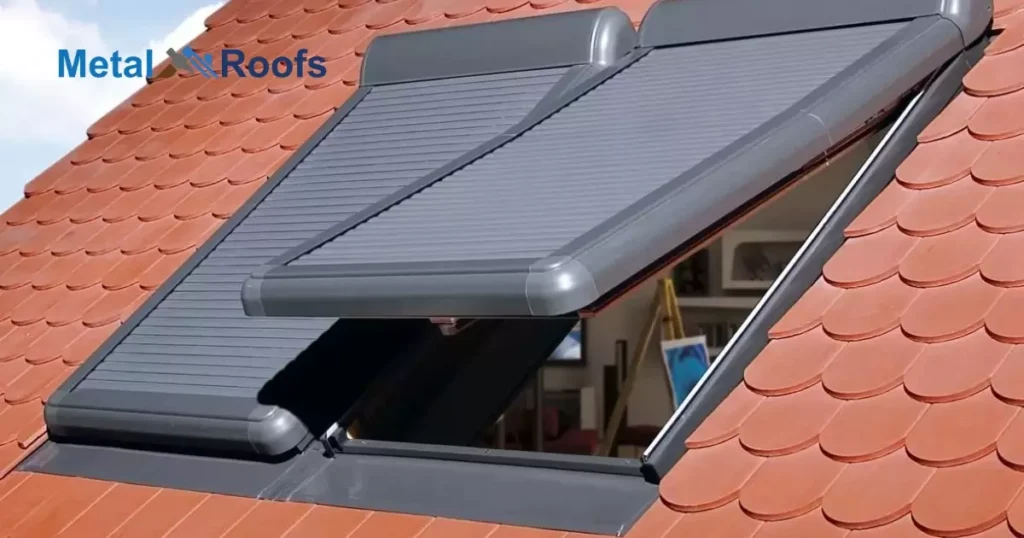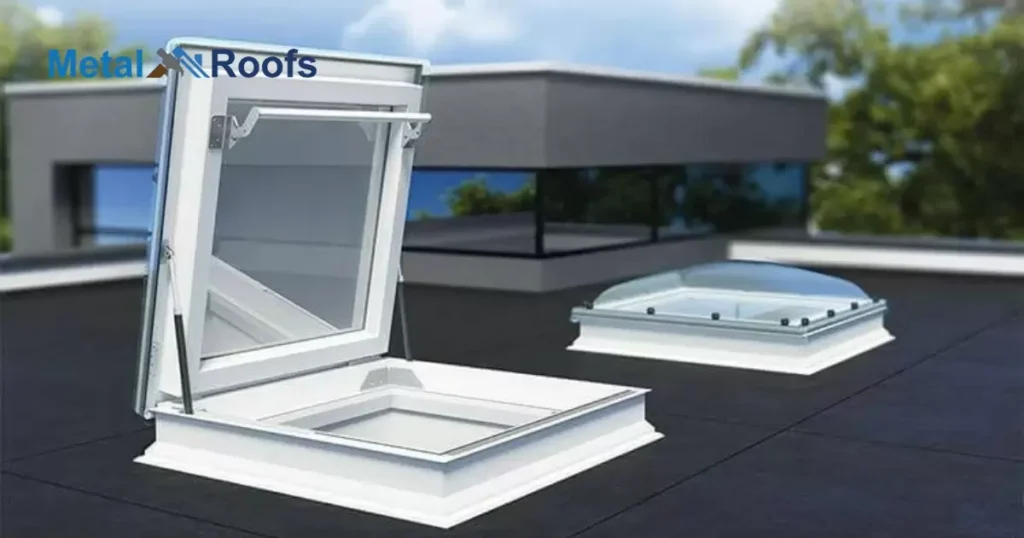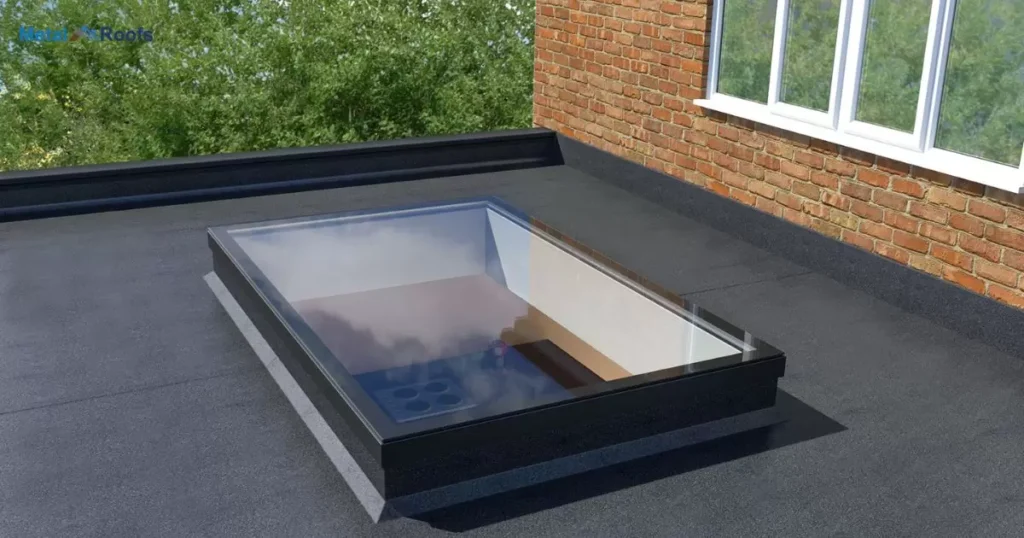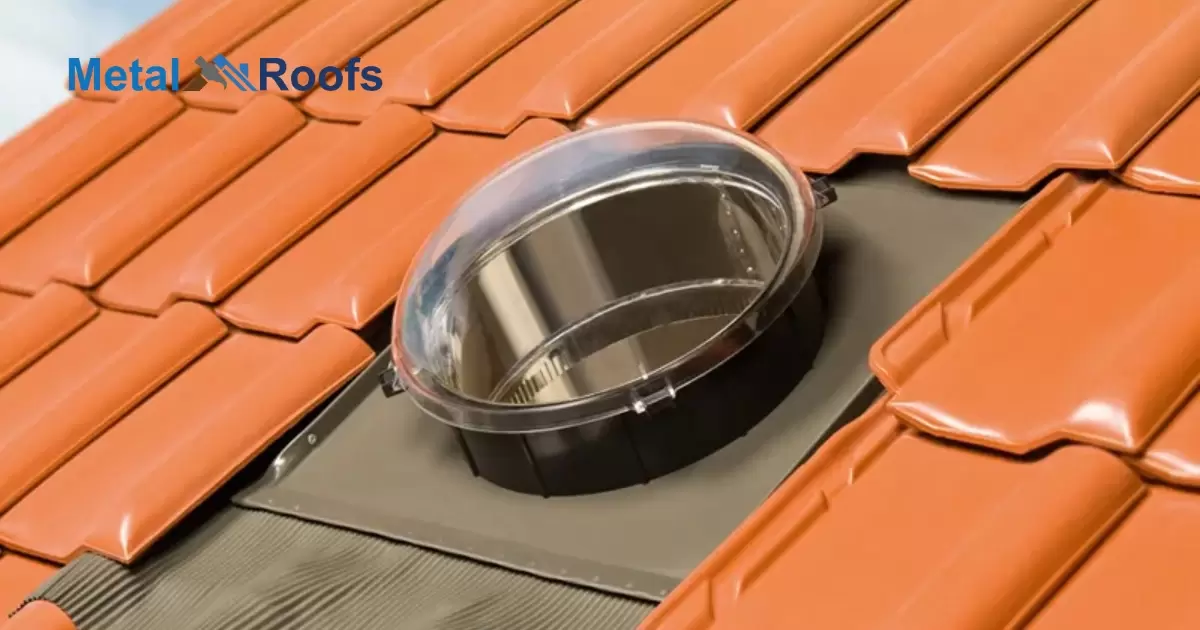Skylights are roof windows that allow natural light into a building. On low slope roofs under 30 degrees, skylights must be mounted on curbs raised above the roofline so water can drain off around them without leaking inside.
Skylights brighten rooms with natural light. But on flat roofs, water pools. how to install skylights on low slope roofs ? Curbs lift skylights above the roofline. Water flows around them. Correct curb height keeps water out. Proper flashing seals joints. Let the sun shine in safely.
Illuminating interiors with natural light is essential. When installing skylights on flat roofs, use curbs to elevate them and prevent leaks. Ensure a watertight seal by carefully sealing curb flashing. Consider using Knauf Ecoroll R 13 Kraft Faced Fiberglass Insulation Roll in all sizes for optimal insulation, following manufacturer instructions for installation.
Key Takeaway
- Skylight kit, adhesive, sealant, screws, membrane.
- Use protective gear, ensure stable ladder placement.
- Confirm roof slope within skylight specs.
- Choose optimal location for lighting and aesthetics.
- Clean and repair roof surface.
- Secure skylight frame with roofing adhesive.
Install Skylights On A Metal Roof
Choosing skylights suitable for metal roofs is key. Start by checking local codes. Gather tools: skylight and flashing kits, roofing sealant, and nails. Measure and mark where skylights go. Cut an opening precisely. Fit the skylight frame securely into the cut opening.
Install the flashing kit provided. Seal seams and edges tightly. Integrate roofing material over the flashing for a watertight seal. Ensure the skylight is sealed, secure, and leak free. If unsure, consider hiring a professional.
Explanation Of The Compatibility Of Skylights With Metal Roofing
| Compatibility Aspect | Explanation |
|---|---|
| Material Compatibility | Skylights are generally compatible with various metal roofing materials such as steel, aluminum, and copper. It is important to choose skylights made from materials that can withstand the same environmental conditions as the metal roofing. |
| Installation Considerations | Metal roofing’s durability and strength make it suitable for supporting skylights. proper installation techniques, including flashing and sealants, are crucial to ensure a watertight and secure fit between the skylight and the metal roofing panels. |
| Thermal Expansion | Both metal roofing and skylights experience thermal expansion and contraction due to temperature changes. Compatibility lies in selecting materials and designs that accommodate these movements without causing stress, leaks, or structural issues. |
Installing skylights on metal roofs is a seamless process when done right. Begin by choosing skylights designed for low slope roofs, ensuring they align with the minimal pitch requirement. Measure and mark the desired location accurately on the metal surface before cutting a precise opening.
Insert the skylight frame securely and use the provided flashing kit for watertight sealing. Integrate the roofing material to overlap the flashing, applying roofing sealant generously for added protection. Finally, inspect for leaks by testing with water, confirming a successful and compatible installation.
Types Of Skylights That Can Be Installed On Metal Roofs
When installing skylights on metal roofs, it’s important to consider both the type of skylight and the compatibility with the roofing material. Here are some types of skylights that can be installed on metal roofs.
Curb-Mounted Skylights: These skylights are mounted on a raised frame or curb, which is attached to the metal roof. Curb mounted skylights provide a good seal against water penetration and are suitable for various roof types, including metal roofs.
Deck-Mounted Skylights: Deck mounted skylights are installed directly onto the metal roof deck, eliminating the need for a separate curb. They provide a sleek and low-profile look, integrating seamlessly with the roof.
Self-Flashing Skylights: These skylights have a built in flashing system designed to integrate with specific roofing materials, including metal. Self flashing skylights are designed to minimize the risk of leaks by providing a tight seal around the installation area.
Structural Skylights: Structural skylights are designed to bear additional loads and can be used in large roof openings to allow more natural light. They are often made with durable materials suitable for various roofing types, including metal.
Pyramid Skylights: Pyramid skylights feature a pyramid-shaped design and are suitable for metal roofs with a high pitch. They offer an aesthetic appeal and can enhance the architectural style of a building.
Fixed or Vented Skylights: Skylights come in fixed or vented (operable) options. Vented skylights can be manually or electronically opened to allow for ventilation. The choice between fixed and vented skylights depends on the desired functionality and the specific needs of the space.
Comparison Of Deck Mounted And Curb Mounted Skylights

Deck-mounted and curb mounted skylights differ in their installation on roofs. Deck mounted skylights sit flush with the roofline, providing a sleek and seamless look. They are suitable for roofs with a pitch of at least 3:12. On the other hand, curb mounted skylights are raised above the roof surface on a curb or frame.
In terms of installation complexity, deck mounted skylights are generally easier to install due to their flush design. They also offer a more contemporary aesthetic. Meanwhile, curb mounted skylights are versatile for varying roof pitches, and their raised design helps prevent water accumulation.
Install Skylights On A Low Slope Metal Roof
Pick skylights meant for low slope metal roofs. Verify local rules and get the needed permits. Grab the skylight kit and essential tools. Plan where to put the skylights, keeping sunlight and interior layout in mind. Measure and mark the spot on the roof. Cut an opening precisely as per skylight instructions.
Place the skylight frame securely in the cut. Install the flashing kit, critical for waterproofing. Blend the skylight with the metal roof, ensuring a tight seal. Seal joints thoroughly using roofing sealant. Test for leaks by spraying water around and inspect for penetration. Finish the interior around the skylight, framing or adding drywall as needed.
Tips For Installing Skylights On A Metal Roof
Installing skylights on a metal roof requires careful planning and execution to ensure proper sealing, waterproofing, and structural integrity. Here are some tips to help you with the installation process.
Choose High-Quality Skylights:
Select skylights that are specifically designed for metal roofs. Ensure they have proper flashing kits and are made from durable materials that can withstand the elements.
Check Local Codes and Permits:
Before starting the installation, check local building codes and obtain any necessary permits. Compliance with regulations is crucial to ensure the safety and legality of your project.
Measure and Plan Carefully:
Accurate measurements and careful planning are essential. Take precise measurements of the skylight location, ensuring it aligns with the roof structure and framing. Plan for proper drainage and consider the angle for optimal sunlight.
Use the Right Flashing:
Metal roofs expand and contract with temperature changes, so it’s crucial to use the correct flashing to accommodate this movement. Flashing kits designed for metal roofs provide a weather tight seal around the skylight.
Apply Sealant Correctly:
Use a high quality roofing sealant compatible with both the skylight material and the metal roof. Apply the sealant generously around the edges of the skylight and under the flashing to prevent water infiltration.
Put A Skylight On A Pitched Roof
Choose a skylight designed for pitched roofs. Check local codes and get any needed permits. Measure and mark the skylight location precisely. Cut an opening in the roof following the manufacturer’s guidelines. Secure the skylight frame in place and install the provided flashing kit.
Integrate the roofing material, overlap with flashing, and seal all edges tightly. Test for leaks by spraying water around the skylight. Finish the interior and enjoy the added natural light. Hiring a professional is wise if unsure about the installation process.
How Large Can Flat Roof Skylights Be?

Flat roof skylights can vary in size, but it’s crucial to consider the roof’s slope. Low slope roofs, choose skylights specifically designed for this purpose. These skylights typically have size limitations to ensure proper water drainage and prevent leaks.
Always follow the skylight manufacturer’s guidelines for sizing and installation. Installing skylights that exceed the recommended size may compromise the roof’s integrity and lead to water related issues. In summary, when it comes to flat roof skylights, go big but stay within the safe size limits to keep your roof dry and trouble free.
How To Choose A Position And Size For Your Skylight?
First, decide where your skylight goes by considering sunlight and room layout. Measure and mark the chosen spot on your roof precisely. When cutting the opening, use the right tools and follow the skylight kit instructions closely. The frame should fit securely into the cut, aligning with your measurements.
Next, install the flashing kit provided, sealing all seams with roofing sealant. Ensure roofing material overlaps the flashing to create a water resistant seal. Before finishing the interior, conduct a thorough leak test by spraying water around the skylight. If there are signs of water penetration, revisit the sealing and flashing steps to guarantee a watertight installation.
Planning Permission Needed for Skylight Installation
If you’re thinking of installing skylights, check local rules first. Different areas have different requirements. Get the necessary permits before cutting any holes in your roof. Choose skylights designed for low-slope roofs.
Measure precisely and cut an opening as instructed. Seal the edges well to prevent leaks. Once installed, test for leaks by spraying water around the skylight. Following these steps ensures a smooth skylight installation without legal hassles.
Roofing A Low Slope Roof
Roofing a low slope roof requires careful planning. Start by cleaning the surface and repairing any damage. Choose a roofing material that suits low slopes. Materials like modified bitumen or TPO work well. Install a base layer of roofing felt and secure it. Add the final layer of roofing material and seal the edges.
Make sure to follow all instructions for the materials you use. Proper flashing and sealing are crucial to prevent leaks. Check the roof for any gaps or weak spots. Maintain your roof regularly to keep it in good shape. A well-installed roof will last longer and protect your home.
Skylights On Flat Roofs

Skylights on flat roofs need careful installation. They should be mounted on a curb to help with drainage. A curb is a small frame built around the skylight. It keeps water from leaking inside. Proper flashing and sealing are also important. This prevents water from getting under the skylight.
A flat roof is not actually flat. It has a slight slope for water drainage. Choose a skylight designed for flat roofs. It should include features for water management. Make sure to follow the manufacturer’s instructions for the best results.
Roll Roofing Installation
Start by preparing the roof surface. Clean it and fix any damage. Roll out the roofing material and cut it to fit. Make sure the edges are straight and aligned. Apply roofing cement to the roof. Lay down the roll and press it into place.
Secure the roll with roofing nails. Place nails around the edges and in the center. Overlap each roll slightly to prevent leaks. Apply more roofing cement over the seams. Inspect the roof for any gaps or issues.
Frequently Asked Questions
What Is The Minimum Pitch For A Skylight?
Choose skylights for low slopes, check codes, and gather tools. Plan, measure, and cut an opening. Install securely with flashing, integrate with roofing, seal edges. Test for leaks, finish interior.
Can I Install Skylight On Flat Roof?
Yes, you can add skylights to a flat roof. Choose skylights for low slopes, follow local codes, and cut a precise opening. Securely install the frame, use the flashing kit, and seal with roofing material.
Can You Put A Skylight On A Pitched Roof?
Yes, you can add a skylight to a pitched roof. Choose the right skylight, cut an opening, install the frame, add flashing, seal edges, and test for leaks. Consider professional help if unsure.
Conclusion
Skylights let in wholesome sunlight. But flat roofs allow water to collect. Install skylights on curbs that lift them up. Properly flashed curbs prevent leaks. Curbs should be tall enough to work with the roof slope. Carefully follow all manufacturer directions. Use self flashing skylights when possible. They simplify the process.
Installing skylights takes some skill. But it is a project a handy homeowner can take on. Using curbs allows skylights to sit atop flat roofs. Careful planning and work prevents future leaks. In the end, enjoy sunlight and save on electric bills. Skylights on flat roofs take effort but deliver joy.











